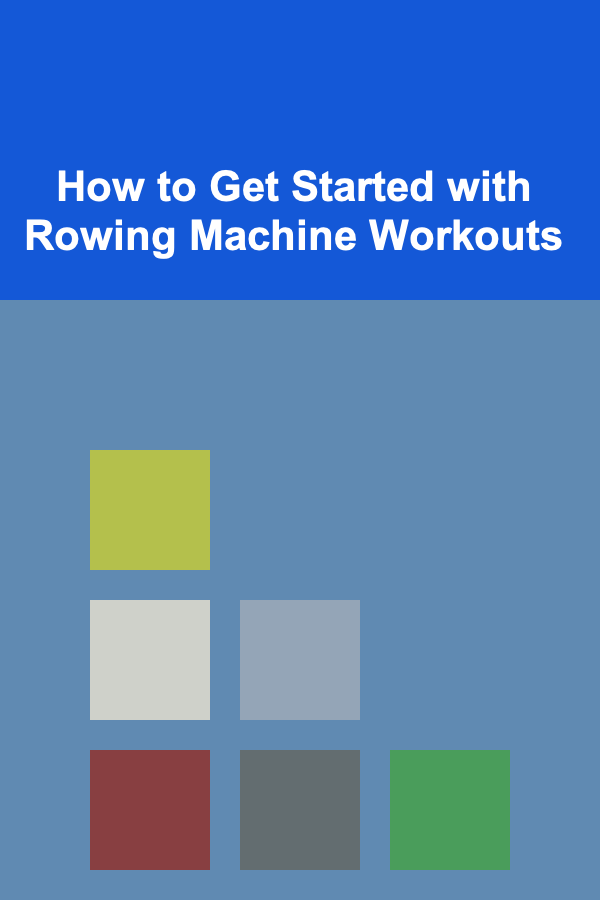
How to Get Started with Rowing Machine Workouts
ebook include PDF & Audio bundle (Micro Guide)
$12.99$6.99
Limited Time Offer! Order within the next:

Rowing machines have gained significant popularity in recent years, thanks to their ability to provide a full-body workout that improves cardiovascular health, strengthens muscles, and promotes overall fitness. Whether you're new to exercise or an experienced gym-goer, incorporating rowing machine workouts into your routine can offer a range of benefits. In this guide, we'll explore how to get started with rowing machine workouts, focusing on technique, workout structure, and tips to help you maximize your training.
Understanding the Rowing Machine
Before diving into specific workouts, it's essential to understand how a rowing machine works and the benefits it offers. A rowing machine simulates the motion of rowing a boat, which involves using a combination of your legs, core, and arms. The primary muscle groups targeted during rowing include the quadriceps, hamstrings, calves, back, shoulders, and arms. Rowing is a low-impact exercise, making it suitable for people of all fitness levels and ages.
Rowing machines typically come with different types of resistance systems:
- Air Resistance: This is the most common type, where resistance increases as you row faster.
- Water Resistance: This mimics the feeling of rowing on water, with resistance increasing based on the speed and force applied to the stroke.
- Magnetic Resistance: This allows for adjustable resistance, providing a quieter workout experience.
- Hydraulic Resistance: These machines have pistons that adjust the resistance, often found in more budget-friendly options.
Proper Rowing Technique
Proper technique is crucial when using a rowing machine, as incorrect form can lead to injury and reduce the effectiveness of your workout. Here's a step-by-step guide to mastering the basic rowing stroke:
1. The Catch Position (Start)
- Sit on the seat and secure your feet in the foot straps. Your knees should be bent, and your shins should be vertical.
- Lean forward slightly at the hips (not the back), with your arms fully extended and your grip firm but relaxed on the handle.
- Your back should be straight, not rounded, and your shoulders should be relaxed.
2. The Drive (Push Phase)
- Push through your legs first, extending your knees and hips.
- As your legs extend, begin to lean back slightly (not a full lean, just a slight backward tilt of the torso).
- Once your legs are fully extended, engage your back muscles to start pulling the handle towards your body.
- Finish the drive by pulling with your arms. The handle should come just under your chest.
3. The Finish (End)
- At the end of the stroke, your legs should be fully extended, and your torso should be slightly leaning back (no more than 15-20 degrees).
- The handle should be close to your body, just below your chest, with your elbows bent and pointing back.
- Hold the finish position briefly before moving into the recovery phase.
4. The Recovery (Return Phase)
- Begin the recovery by extending your arms back toward the machine.
- Once your arms are fully extended, lean your torso forward slightly from the hips.
- Bend your knees to slide the seat back towards the catch position.
- Repeat the process smoothly and fluidly, maintaining consistent motion.
Proper breathing is also essential during rowing. Inhale as you recover (when you are coming back to the starting position), and exhale as you drive (when you are pushing the legs and pulling the handle).
Getting Started with Rowing Machine Workouts
Now that you understand the basic technique, let's talk about how to get started with rowing machine workouts. If you're new to rowing, it's important to start slow and focus on learning the proper technique before increasing intensity. Here's a structured plan for beginners:
Week 1: Building Familiarity
Goal: Get accustomed to the rowing machine, focus on form and technique.
- Warm-Up (5-10 minutes): Start with light rowing at a comfortable pace. Focus on your technique, making sure your form is correct.
- Main Set (10-15 minutes): Row at a steady, moderate pace. You can aim for around 15-20 strokes per minute. Pay attention to your technique and try to keep a consistent rhythm.
- Cool-Down (5 minutes): End with slow rowing and gentle stretching to relax your muscles.
Week 2: Introducing Intervals
Goal: Start building endurance and strength with short bursts of intensity.
- Warm-Up (5-10 minutes): Continue to focus on technique while warming up at an easy pace.
- Main Set (20-25 minutes): Alternate between 1 minute of high-intensity rowing and 2 minutes of low-intensity recovery. Repeat this cycle 6-8 times.
- Cool-Down (5 minutes): Slow rowing followed by stretching.
Week 3: Increasing Intensity
Goal: Challenge yourself with longer intervals and slightly higher intensity.
- Warm-Up (5-10 minutes): Gradually increase your intensity to prepare for the upcoming workout.
- Main Set (25-30 minutes): Try 2 minutes of high-intensity rowing followed by 2 minutes of low-intensity rowing. Repeat for 8-10 cycles.
- Cool-Down (5-10 minutes): Gradually decrease your intensity and finish with some static stretching.
Week 4: Endurance Building
Goal: Increase rowing time and work on building overall stamina.
- Warm-Up (5-10 minutes): Focus on slow, controlled rowing.
- Main Set (30-40 minutes): Row at a moderate pace for 20-30 minutes without intervals, aiming for 20-25 strokes per minute.
- Cool-Down (5-10 minutes): Gradually reduce your intensity and stretch.
Advanced Rowing Workouts
Once you've built a foundation of technique and stamina, you can increase the complexity of your workouts. Here are some advanced rowing workouts to help you continue progressing:
1. Pyramid Intervals
- Row for 1 minute at high intensity, then 1 minute at low intensity.
- Increase the high-intensity intervals by 1 minute (e.g., 2 minutes at high intensity, 2 minutes at low intensity).
- Continue this pyramid structure up to 5 minutes at high intensity, then work your way back down.
2. Sprints
- Row 20-30 seconds at maximum effort followed by 1 minute of active recovery (low-intensity rowing).
- Repeat this sprint-recovery cycle for 10-15 rounds.
3. 10K Challenge
- Row a steady pace for 10,000 meters (or 10 kilometers).
- Aim to maintain a consistent stroke rate of 20-22 strokes per minute and moderate intensity.
Incorporating Rowing into Your Fitness Routine
To get the most out of your rowing workouts, consider how they fit into your overall fitness routine. Rowing can serve as both a strength-building and cardiovascular workout, so it pairs well with other types of training, such as weightlifting, running, or cycling.
Combining Rowing with Strength Training
Rowing primarily targets your back, arms, and legs, but it's essential to balance these with upper body and core workouts. If you're training for strength, focus on rowing for cardiovascular benefits and use strength training exercises to target other muscle groups.
Cross-Training with Other Cardio Activities
Since rowing is a full-body workout, it's great for cross-training. If you enjoy running or cycling, consider adding rowing into your routine to give your joints a break from high-impact activities. Rowing complements these workouts well by providing a low-impact alternative that still challenges your cardiovascular system.
Tips for Success
- Track Your Progress: Many rowing machines come with performance tracking, so take advantage of this feature. Track your distance, time, and average stroke rate to monitor improvements.
- Rest and Recovery: Like any workout, rowing requires adequate recovery time. Be sure to allow your muscles to recover by taking rest days or focusing on other types of exercise.
- Stay Consistent: Rowing can be challenging, especially at the beginning, but consistency is key. Aim for at least 2-3 rowing workouts per week to see improvements.
- Challenge Yourself Gradually: As you build stamina, increase the intensity or duration of your workouts. Pushing yourself just beyond your comfort zone will help you achieve better results over time.
Conclusion
Rowing machine workouts are a fantastic way to improve cardiovascular health, build muscle, and enhance overall fitness. By focusing on proper technique, building your workouts gradually, and staying consistent, you can achieve impressive results. Whether you're aiming to lose weight, improve endurance, or increase strength, the rowing machine is a versatile tool that can help you reach your goals. Start slowly, challenge yourself, and enjoy the process of becoming fitter and stronger with every row.

Building Stronger Relationships: Tips and Tricks for Effective Communication with Customers as a Customer Support Specialist
Read More
How to Add a Second Story to Your Home Without a Major Overhaul
Read More
How to Maintain Your Renovated Home to Keep It Looking Fresh
Read More
How To Use Personal Branding for Career Leverage
Read More
How To Explore the Evolution of Ska Music
Read More
How to Create a Sustainable Weight Loss Plan
Read MoreOther Products

Building Stronger Relationships: Tips and Tricks for Effective Communication with Customers as a Customer Support Specialist
Read More
How to Add a Second Story to Your Home Without a Major Overhaul
Read More
How to Maintain Your Renovated Home to Keep It Looking Fresh
Read More
How To Use Personal Branding for Career Leverage
Read More
How To Explore the Evolution of Ska Music
Read More